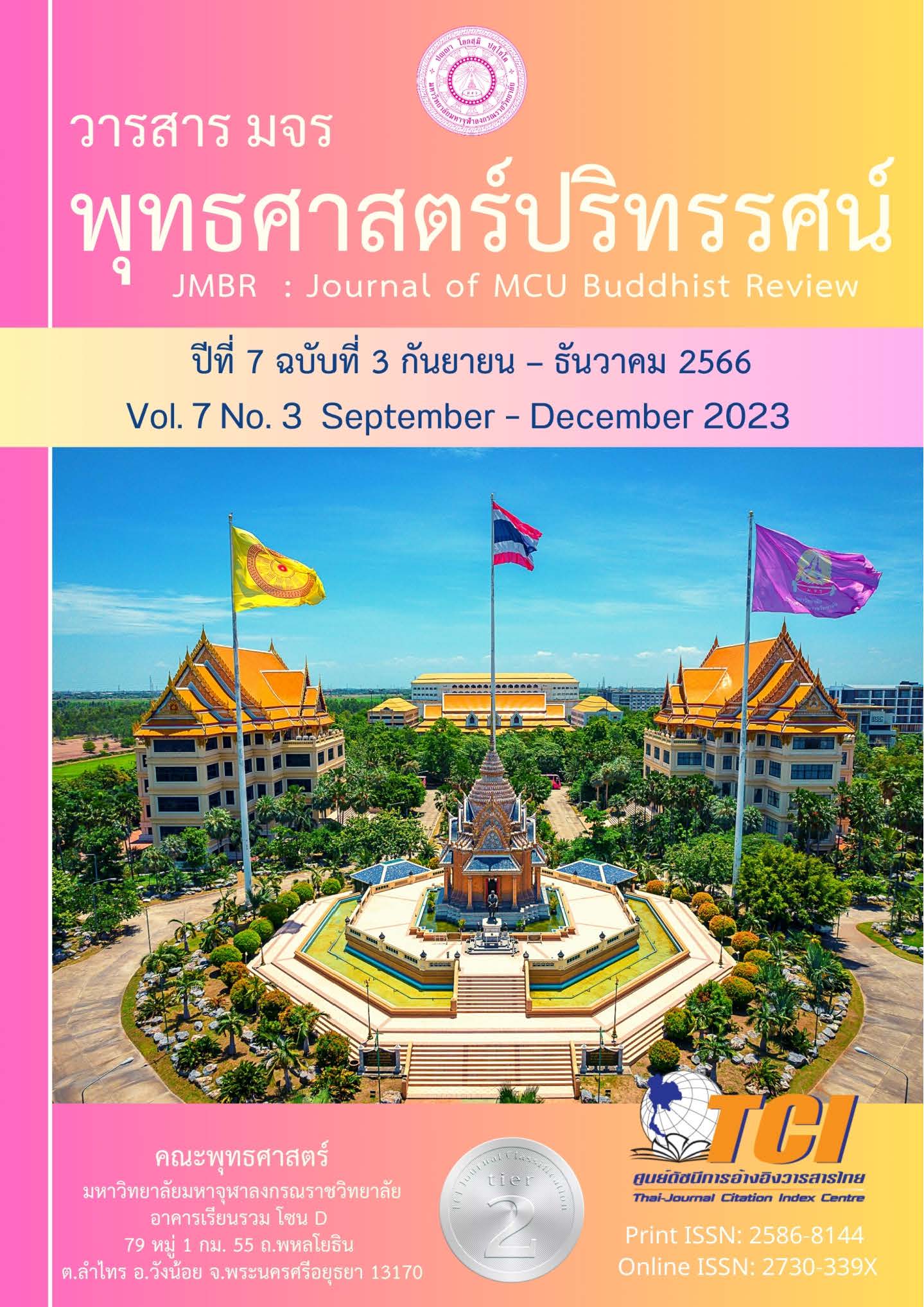เพลงลูกทุ่งอีสาน: ภาพตัวแทนสังคมวัฒนธรรมและกลวิธีการใช้ภาษา
Main Article Content
บทคัดย่อ
บทความวิจัยนี้มีวัตถุประสงค์ 1) เพื่อศึกษาภาพตัวแทนสังคมวัฒนธรรมในเพลงลูกทุ่งอีสาน และ 2) เพื่อศึกษากลวิธีการใช้ภาษาของเพลงลูกทุ่งอีสาน โดยใช้ระเบียบวิธีวิจัยเชิงคุณภาพ เพลงที่นำมาวิเคราะห์มาจาก YouTube เป็นเพลงลูกทุ่งล้านวิว จำนวน 20 บทเพลง โดยมีกรอบแนวคิดภาพตัวแทนและแนวคิดกลวิธีการใช้ภาษา ผู้ศึกษานำเสนอผลการศึกษาค้นคว้าแบบพรรณนาวิเคราะห์
ผลการการวิจัยพบว่า 1) ภาพตัวแทนสังคมวัฒนธรรมของเพลงลูกทุ่งอีสาน ผู้ประพันธ์นำเสนอภาพตัวแทนสังคมวัฒนธรรม โดยใช้กรอบแนวคิดภาพตัวแทนในการวิเคราะห์เนื้อหาเพลงเกี่ยวกับสังคมวัฒนธรรม แบ่งได้ 5 ด้าน คือ ด้านครอบครัว ด้านอาชีพ ด้านศาสนาและความเชื่อ ด้านขนบธรรมเนียมประเพณี และด้านค่านิยม ซึ่งพบว่าภาพตัวแทนในเพลงลูกทุ่งอีสานด้านครอบครัว พบมากที่สุด โดยจะพบในเรื่องของความรัก และการดำเนินชีวิต รองลงมาคือด้านอาชีพ ด้านศาสนาและความเชื่อ ด้านขนบธรรมเนียมประเพณี ด้านค่านิยม ตามลำดับ โดยจะแสดงให้เห็นถึงภาพตัวแทนสังคมวัฒนธรรม และชี้ให้เห็นถึงภาพตัวแทนที่หลากหลายของผู้คนในสังคม ซึ่งจะทำให้ผู้ฟังเกิดความสนใจและติดตามเนื้อเพลงต่อไป 2) ด้านกลวิธีการใช้ภาษาในเพลงลูกทุ่งอีสาน แบ่งได้ออกเป็น 2 ประเด็นคือ กลวิธีการใช้คำ และกลวิธีการใช้โวหารภาพจน์ พบว่า (1) กลวิธีการใช้คำ ประกอบด้วย การใช้คำภาษาถิ่น การใช้คำซ้ำและประโยคซ้ำ การใช้คำหยาบ การใช้คำภาษาต่างประเทศ และ (2) กลวิธีการใช้โวหารภาพพจน์ พบ 6 ประเภท ได้แก่ อุปมา อุปลักษณ์ สัญลักษณ์ อธิพจน์ บุคลาธิษฐาน และปฏิปุจฉา ทั้งนี้ยังพบว่าภาษาที่ใช้ในบทเพลงลูกทุ่งอีสานผู้ประพันธ์ใช้คำภาษาถิ่น ทำให้เข้าใจง่าย ตรงไปตรงมา และยังแสดงความเป็นท้องถิ่นอีสาน การดำเนินชีวิต ความเชื่อ ขนบธรรมเนียมประเพณีอันดีงามไว้ ผู้ฟังได้รับอรรถรสและสำนึกรักบ้านเกิด รวมทั้งข้อคิดและการดำเนินชีวิตไว้ในบทเพลง
Article Details

อนุญาตภายใต้เงื่อนไข Creative Commons Attribution-NonCommercial-NoDerivatives 4.0 International License.
- บทความที่ได้รับการตีพิมพ์เป็นลิขสิทธิ์ของวารสาร มจร พุทธศาสตร์ปริทรรศน์
- ข้อความใดๆ ที่ปรากฎในบทความที่ได้รับการตีพิมพ์ในวารสาร ถือเป็นความรับผิดชอบของผู้เขียนบทความ และข้อคิดเห็นนั้นไม่ถือว่าเป็นทัศนะและความรับผิดชอบของกองบรรณาธิการวารสาร มจร พุทธศาสตร์ปริทรรศน์
เอกสารอ้างอิง
เจตนา นาควัชระ. ทฤษฎีเบื้องต้นแห่งวรรณคดี. กรุงเทพฯ: ดวงกมล, 2521.
พันธกานต์ ทานนท์ (2559). การสื่อสารภาพตัวแทนของผู้หญิงชนบทในเพลงลูกทุ่ง. ขับร้องโดย ตั๊กแตน ชลดา. วิทยานิพนธ์วารสารศาสตรมหาบัณฑิต สาขาวิชาการบริหารสื่อสารมวลชน: มหาวิทยาลัยธรรมศาสตร์.
พรทิพย์ ฉายกี่ และจันทนา แก้ววิเชียร. (2561). วิเคราะห์แนวคิดและศิลปะการใช้ภาษาในวรรณกรรมเพลงลูกทุ่ง แต่งโดย สลา คุณวุฒิ. วารสารเพชรบูรณ์สาร. 20(1), 91-99.
พีรพงษ์ เคนทรภักดิ์. (2564). วาทกรรมความรักในบทเพลงลูกทุ่งอีสานร่วมสมัย. วิทยานิพนธ์ศิลปศาสตรมหาบัณฑิต สาขาวิชาภาษาไทย: มหาวิทยาลัยมหาสารคาม.
พีรพงษ์ เคนทรภักดิ์ และโสภี อุ่นทะยา. (2564). กลวิธีทางภาษาในบทเพลงลูกทุ่งอีสานร่วมสมัย. วารสารศิลปการจัดการ. 5(2), 442-457.
วัชรวีร์ ไชยยายนต์. (2566). การวิเคราะห์ภาพตัวแทนของผู้หญิงล้านนาในละครโทรทัศน์แนวย้อนยุคบริบทภาคเหนือ. นิเทศศาสตรมหาบัณฑิต สาขาวิชานิเทศศาสตร์: จุฬาลงกรณ์มหาวิทยาลัย.
วรรษา คูตระกูล. (2558). การวิเคราะห์เนื้อเพลงที่สะท้อนความเชื่อและค่านิยม: กรณีศึกษาโครงการเพชรในเพลง. วารสารจันทรเกษมสาร. 21(40), 49-57.
สิริชญา คอนกรีต. (2560). กลวิธีทางภาษาในเพลงลูกทุ่งเพื่อสื่อสารอัตลักษณ์และการเมืองเชิงวัฒนธรรมของคนอีสานพลัดถิ่น. Veridian E-Journal. 10(2), 1576-1594.
เอี่ยม อามาตย์มุลตรี. (2560). กลวิธีทางภาษา: การสื่อความทางเพศในเพลงลูกทุ่งอีสาน. วารสารมหาวิทยาลัยมหามกุฏราชวิทยาลัย วิทยาเขตร้อยเอ็ด. 6(2), 196-205.


